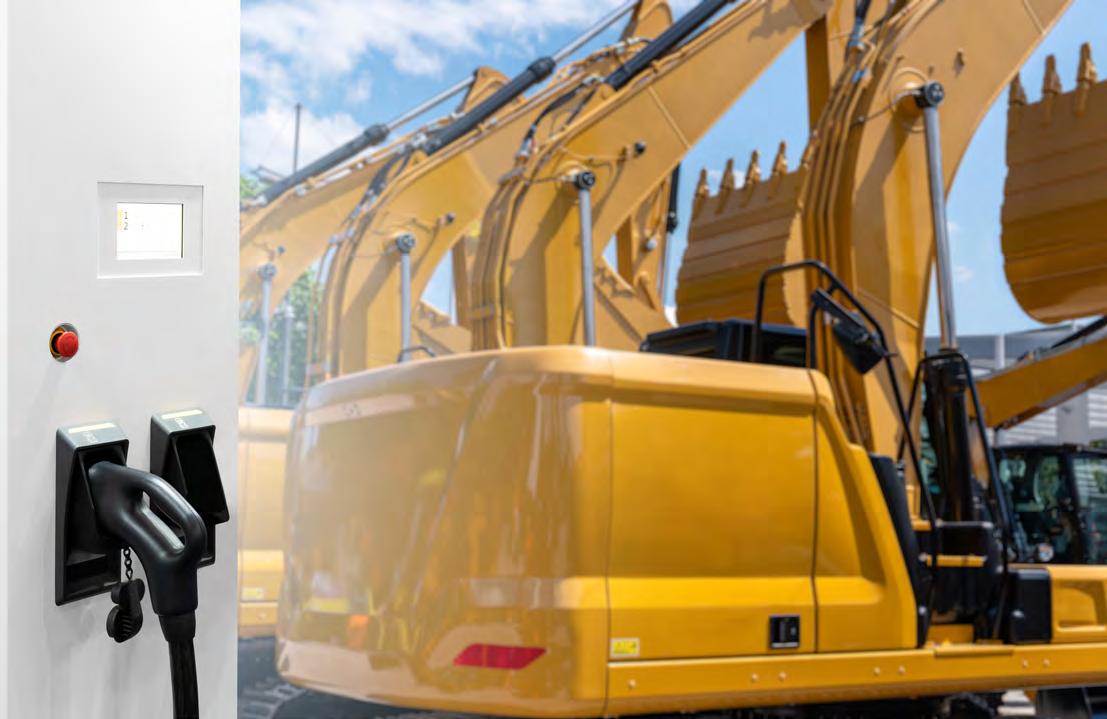
2 minute read
Commercial Vehicle eMobility – potential electrified solutions
This is the second in a series of three articles discussing eMobility and Commercial Vehicles. Each one looking at the accelerating Commercial Vehicle (CV) development, the challenges slowing this down, and the expected pace and direction of electrification. Highlighting how the latest dedicated Electric Vehicle (EV) lubricant technologies can help manage the divergent hardware designs that are emerging and maximise reliability and efficiency.
The parc of medium and heavy duty ICE trucks are currently forecasted to keep growing steadily until at least 2040. Hybridisation may be adopted for some applications until battery technology matures sufficiently. Electric CV sales are expected to grow faster than ICE over this time, but from a much lower base.
Applications such as excavators lend themselves very well to hybridisation, based on the drive cycle. A conventional excavator will spend long periods idling. A hybrid in the same vehicle could run at a steady state with a smaller engine instead. When in use many of an excavator’s movements involve changes of direction, which could benefit greatly from energy recovery. When in use many of an excavator’s movements involve changes of direction, which could benefit greatly from energy recovery. For example, recovery of potential energy as a load in the bucket is lowered, and recovery of kinetic energy rather than braking the cab swing. Meanwhile, other off road applications with very different duty cycles could be some of the last to electrify and benefit very little from hybridisation, such as tractors doing heavy draft work on soil, where a continuous tractive effort is required.
What is putting the brakes on CV electrification?
Despite the top-down pressure of emissions legislation, significant barriers to battery electric commercial vehicle (BECV) adoption still exist. Many of them are the same as for passenger car EVs: infrastructure, energy density and energy demand.
Adequate infrastructure
Without enough charging facilities across the road network – or integrated within the road network, in the case of overhead or induction charging – mass uptake of BECVs will simply not be practical. Likewise, an entire new network of hydrogen filling stations would be required to support the mass adoption of FCCVs (Fuel Cell Commercial Vehicles).
Another aspect of infrastructure is the ability to guarantee supply of battery modules (with a sufficient supply of processed lithium and the ethical supply of other elements needed for battery manufacture, such as cobalt and nickel). Recycling may also play a part here, as manufacturers strive towards a circular economy.
Energy density
Particularly pertinent to BECVs, the energy density of the batteries will determine the feasibility of longer-haul freight. Every kilogram of on-board batteries will reduce the payload that an electric truck can haul, as well as the number of hours it can operate before needing to recharge. If the energy density equation is not in favour of profitable long-haul operation, BECVs will not be a viable solution.
Energy demand
This refers to the energy demand on the power grid, not the vehicle itself. Sufficient energy will first need to be generated, ideally with a low carbon footprint. Storing and distributing this energy in an efficient manner will require smart grids to be introduced before widespread BECV uptake can be supported.
Which CV electrification solutions will win?
With emissions standards becoming so stringent it’s expected that hybrids will mainly be utilised as a bridging technology in many markets, ramping up to a modest global market share before plateauing. Although hybrids offer particular advantages for off-road and start-stop applications, OEMs will likely still need to embrace full electric solutions in order to meet future emissions limits.
© 2022. Afton Chemical Corporation is a wholly owned subsidiary of NewMarket Corporation (NYSE:NEU). 09/22. The information in this bulletin is, to our best knowledge, sure and accurate, but all recommendations or suggestions are made without guarantee since the conditions of use are beyond our control. Afton Chemical Corporation and its affiliates disclaim any liability incurred in connection with the use of these data or suggestions. Furthermore, nothing contained herein shall be construed as a recommendation to use any product in conflict with existing patents covering any material or its use.



